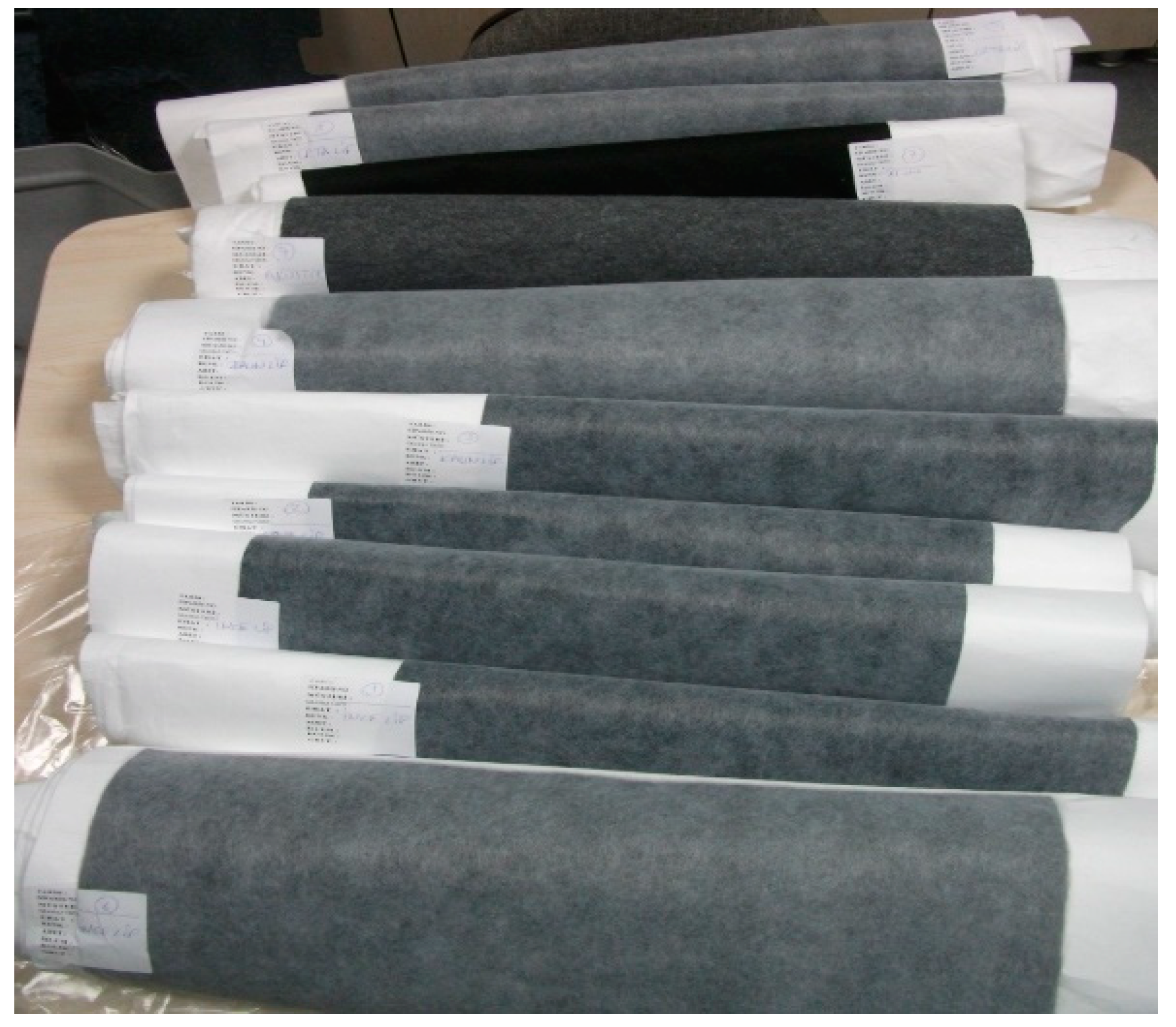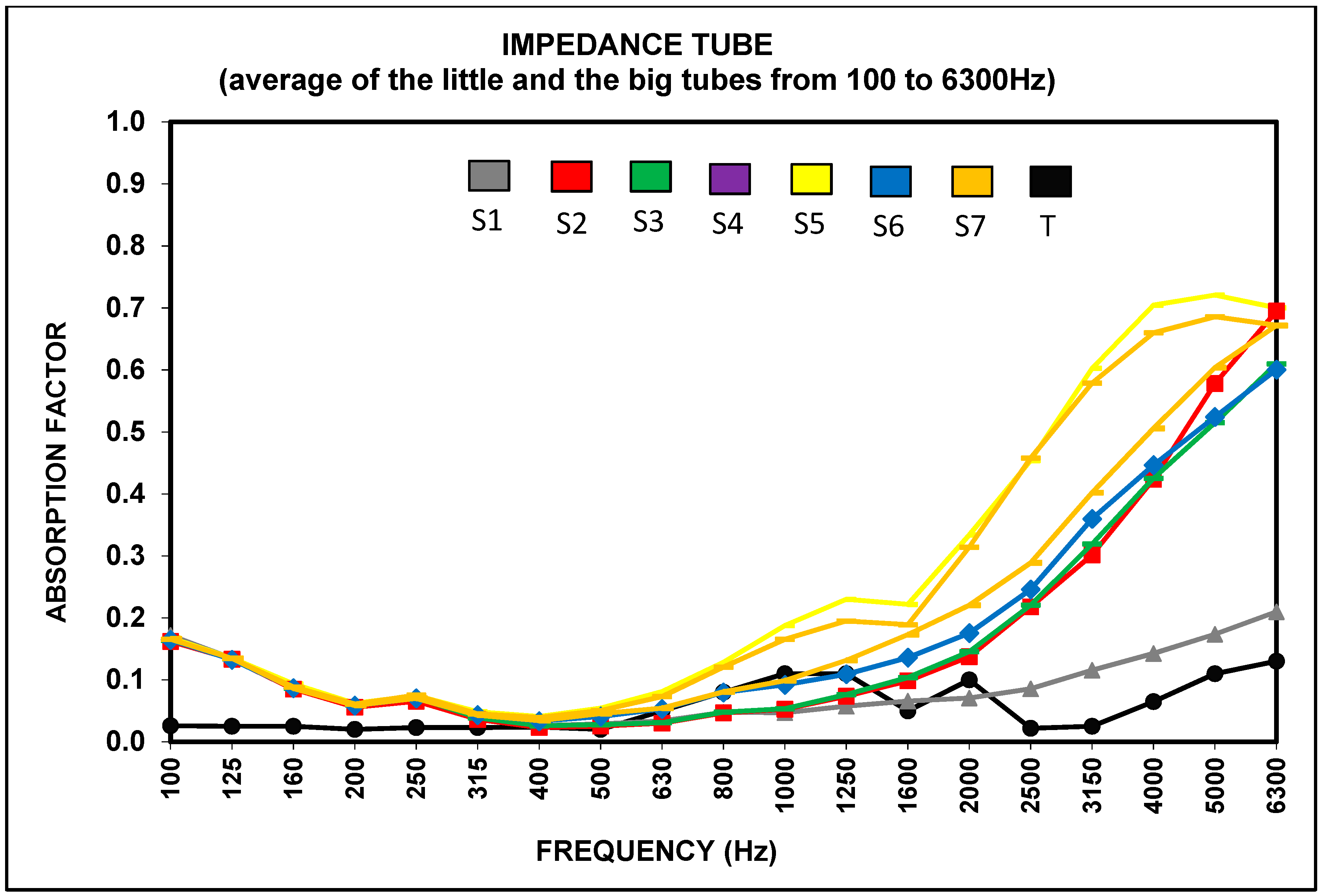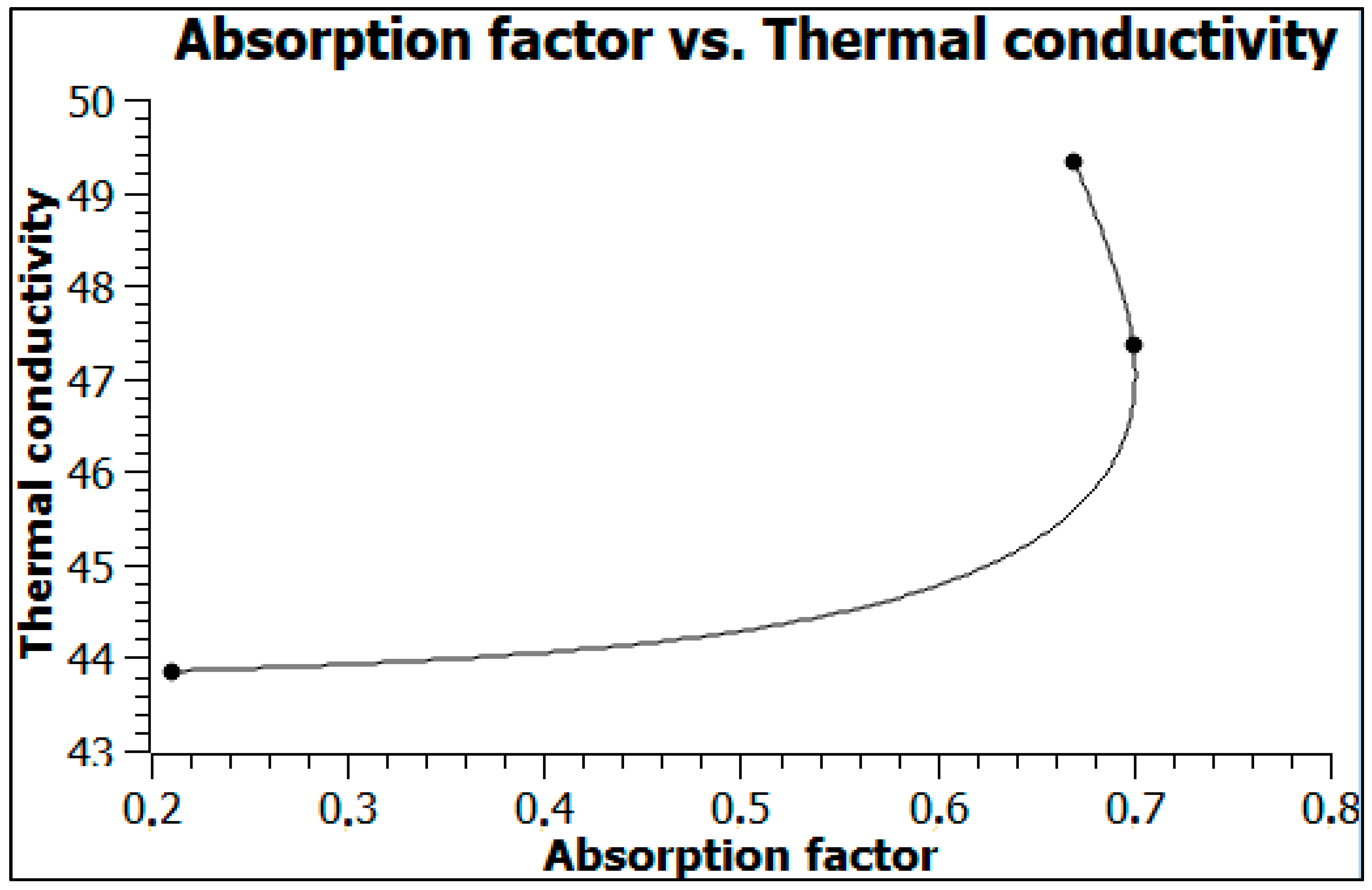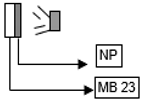Surface Coating of Needle-Punched Nonwovens with Meltblown Nonwovens to Improve Acoustic Properties
Abstract
:1. Introduction
2. Materials and Methods
2.1. Material
2.2. Method
3. Results
4. Discussion
5. Conclusions
- The needle-punched nonwoven fabric provides the lowest sound absorption performance for all frequencies when it is used alone.
- Meltblown fabrics produced at two different rpms performed remarkably better than needle-punched nonwoven when they are used alone. Of these fabrics, the meltblown fabric produced at 23 rpm outperformed the other meltblown fabric (28 rpm) in low, medium and higher frequencies. The finer diameter contributed to the acoustic performance of the material.
- For the hybrid, when the meltblown fabric was placed at the face and the needle-punched was placed at the bottom, it provided a higher sound absorption performance compared to the hybrid samples having the opposite arrangement. It can be explained by higher surface area and finer fibre diameter greatly contributing to the acoustic performance. Therefore, it is better to place the finer diameter fibrous material on the face when higher sound absorption performance is desired in fibrous hybrid structures. This phenomenon also contributed to an increase in thermal conductivity values of the hybrid structures that would possibly advance sound absorption capability by transferring a higher amount of the heat energy that was converted from sound energy.
- The needle-punched nonwoven/meltblown hybrid samples performed slightly better than meltblown alone fabrics in sound absorption in general.
- Contrary to theory, higher mass and thickness did not make needle-punched nonwoven the best material for acoustic performance. On the other hand, meltblown nonwovens and their hybrid combinations performed better due to their finer diameter and surface area even though they have lower mass and thickness.
Outlook and Suggested Future Work
Author Contributions
Funding
Institutional Review Board Statement
Informed Consent Statement
Data Availability Statement
Conflicts of Interest
References
- De Paiva Vianna, K.; Rodrigues, R.M.; Alves, C.M. Noise pollution and annoyance: An urban soundscapes study. Noise Health 2015, 17, 125–133. [Google Scholar] [CrossRef] [PubMed]
- Test, T.; Canfi, A.; Eyal, A.; Shoam-Vardi, I.; Sheiner, E.K. The Influence of Hearing Impairment on Sleep Quality Among Workers Exposed to Harmful Noise. Sleep 2011, 34, 25–30. [Google Scholar] [CrossRef] [PubMed] [Green Version]
- Tang, X.; Yan, X. Multi-layer fibrous structures for noise reduction. J. Text. Inst. 2017, 108, 2096–2106. [Google Scholar] [CrossRef]
- Fung, W.; Hardcastle, M. Textiles in Automotive Engineering, 1st ed.; Technomic Publishing Co.: Lancaster, UK, 2001; pp. 1–23. [Google Scholar]
- Kang, Y.; Lee, E.; Lee, K.; Choi, S.; Shin, E. Acoustic properties of sound-absorbing polyester fabrics woven with thick staple and thin draw textured yarn for use in interior decoration. J. Text. Inst. 2019, 110, 202–210. [Google Scholar] [CrossRef]
- Tang, X.; Yan, X. Acoustic energy absorption properties of fibrous materials: A review. Compos. Part Appl. Sci. Manuf. 2017, 101, 360–380. [Google Scholar] [CrossRef]
- Moretti, E.; Belloni, E.; Agosti, F. Innovative mineral fiber insulation panels for buildings: Thermal and acoustic characterization. Appl. Energy 2016, 169, 421–432. [Google Scholar] [CrossRef]
- Küçük, M.; Korkmaz, Y. The effect of physical parameters on sound absorption properties of natural fiber mixed nonwoven composites. Text. Res. J. 2012, 82, 2043–2053. [Google Scholar] [CrossRef]
- Soyaslan, D. High structural insulation composite material development with electromagnetic protection effect reinforced with carbon fibers and particles. J. Ind. Text. 2021, 51, 424–434. [Google Scholar] [CrossRef]
- Liu, X.; Yan, X.; Zhang, H. Effects of pore structure on sound absorption of kapok-based fiber nonwoven fabrics at low frequency. Text. Res. J. 2016, 86, 755–764. [Google Scholar] [CrossRef]
- Yang, T.; Xiong, X.; Mishra, R.; Novak, J.; Militky, J. Sound absorption and compression properties of perpendicular-laid nonwovens. Text. Res. J. 2019, 89, 612–624. [Google Scholar] [CrossRef]
- Zakriya, G.M.; Ramakrishnan, G. Insulation and mechanical properties of jute and hollow conjugated polyester reinforced nonwoven composite. Energy Build. 2018, 158, 1544–1552. [Google Scholar] [CrossRef]
- Berardi, U.; Iannace, G. Acoustic characterization of natural fibers for sound absorption applications. Build. Environ. 2015, 94, 840–852. [Google Scholar] [CrossRef]
- Ganesan, P.; Karthik, T. Development of acoustic nonwoven materials from kapok and milkweed fibres. J. Text. Inst. 2016, 107, 477–482. [Google Scholar] [CrossRef]
- Bhat, G.; Messiry, M.E. Effect of microfiber layers on acoustical absorptive properties of nonwoven fabrics. J. Ind. Text. 2020, 50, 312–332. [Google Scholar] [CrossRef]
- Na, Y.; Lancaster, J.; Casali, J.; Cho, G. Sound Absorption Coefficients of Micro-fiber Fabrics by Reverberation Room Method. Text. Res. J. 2007, 77, 330–335. [Google Scholar] [CrossRef]
- Rabbi, A.; Bahrambeygi, H.; Nasouri, K.; Shoushtari, A.M.; Babaei, M.R. Manufacturing of PAN or PU Nanofiber Layers/PET Nonwoven Composite as Highly Effective Sound Absorbers. Adv. Polym. Technol. 2014, 33, 21425. [Google Scholar] [CrossRef]
- Kucukali-Ozturk, M.; Ozden-Yenigun, E.; Nergisi, B.; Candan, C. Nanofiber-enhanced lightweight composite textiles for acoustic applications. J. Ind. Text. 2017, 46, 1498–1510. [Google Scholar] [CrossRef] [Green Version]
- Rabbi, A.; Bahrambeygi, H.; Shoushtari, A.M.; Nasouri, K. Incorporation of Nanofiber Layers in Nonwoven Materials for Improving Their Acoustic Properties. J. Eng. Fibers Fabr. 2013, 8, 155892501300800412. [Google Scholar] [CrossRef]
- Xiang, H.; Tan, S.; Yu, X.; Long, Y.; Zhang, X.; Zhao, N.; Xu, J. Sound absorption behavior of electrospun polyacrylonitrile nanofibrous membranes. Chin. J. Polym. Sci. 2011, 29, 650–657. [Google Scholar] [CrossRef]
- Palak, H.; Kayaoğlu, B.K. Analysis of the effect of fiber cross section and different bonding methods on sound absorption performance of PET fiber based nonwovens using Taguchi method. J. Text. Inst. 2020, 111, 575–585. [Google Scholar] [CrossRef]
- Gliścińska, E.; Michalak, M.; Krucińska, I. Sound absorption property of nonwoven based composites. Autex Res. J. 2013, 13, 150–155. [Google Scholar] [CrossRef] [Green Version]
- Ramamoorthy, M.; Pisal, A.A.; Rengasamy, R.S.; Rao, A.V. In-situ synthesis of silica aerogel in polyethylene terephthalate fibre nonwovens and their composite properties on acoustical absorption behavior. J. Porous Mater. 2018, 25, 179–187. [Google Scholar] [CrossRef]
- Islam, S.; Alam, S.M.M.; Akter, S. Mathematical investigation of the thermal conductivity of fabrics using thermal equation. Mater. Today Proc. 2020, 46, 413–424. [Google Scholar] [CrossRef]
- Reetz, C.; Fischer, R.; Assumpcao, G.G.; McNally, D.P.; Burns, P.S.; Sankey, J.C.; Regal, C.A. Analysis of Membrane Phononic Crystals with Wide Band Gaps and Low-Mass Defects. Phys. Rev. Appl. 2019, 12, 44027. [Google Scholar] [CrossRef] [Green Version]
- Jin, Y.; Walker, E.; Choi, T.; Neogi, A.; Krokhin, A. Simultaneous negative reflection and refraction and reverse-incident right-angle collimation of sound in a solid-fluid phononic crystal. J. Acoust. Soc. Am. 2022, 151, 2723–2731. [Google Scholar] [CrossRef]
- Gül, S.; Sivri, Ç.; Aksu, O.R. The selection of face mask as a personal protective equipment under the spherical fuzzy environment considering technical and material properties. Int. J. Cloth. Sci. Technol. 2022. ahead of print. [Google Scholar] [CrossRef]
- Varghese, G.; David, D.A.; Karuth, A.; Manamkeri Jafferali, J.F.; Begum, S.; George, J.J.; Rasulev, B.; Raghavan, P. Experimental and Simulation Studies on Nonwoven Polypropylene–Nitrile Rubber Blend: Recycling of Medical Face Masks to an Engineering Product. ACS Omega 2022, 7, 4791–4803. [Google Scholar] [CrossRef]
- Maderuelo-Sanz, R.; Acedo-Fuentes, P.; García-Cobos, F.J.; Sánchez-Delgado, F.J.; Mota-López, M.I.; Meneses-Rodríguez, J.M. The recycling of surgical face masks as sound porous absorbers: Preliminary evaluation. Sci. Total Environ. 2021, 786, 147461. [Google Scholar] [CrossRef]
- Sengupta, S. Sound reduction by needle-punched nonwoven fabrics. Indian J. Fibre Text. Res. 2010, 35, 237–242. [Google Scholar]
- Jia, M.G.; Yan, R.S.; Cao, B.; Shi, J. Investigation on the structure and mechanical properties of acoustic-absorbing composite laminates. IOP Conf. Ser. Mater. Sci. Eng. 2018, 382, 22084. [Google Scholar] [CrossRef] [Green Version]
- Hoda, N.; Mert, F.; Kara, F.; Atasagun, H.G.; Bhat, G.S. Effect of Process Parameters on Fiber Diameter and Fiber Distribution of Melt-Blown Polypropylene Microfibers Produced by Biax Line. Fibers Polym. 2021, 22, 285–293. [Google Scholar] [CrossRef]
- Messiry, M.E.; Bhat, G.; Eloufy, A.; Latif, S.A.; Ayman, Y. Acoustical absorptive properties of meltblown nonwovens for textile machinery. Text. Res. J. 2020, 91, 1341–1353. [Google Scholar] [CrossRef]
- International Standards Organization. Available online: https://www.iso.org/standard/22851.html (accessed on 25 April 2022).
- Ghorbani, K.; Hasani, H.; Zarrebini, M.; Saghafi, R. An investigation into sound transmission loss by polypropylene needle-punched nonwovens. Alex. Eng. J. 2016, 55, 907–914. [Google Scholar] [CrossRef] [Green Version]
- Temesgen, A.G.; Eren, R.; Aykut, Y.; Süvari, F. Evaluation of Enset Fabric Reinforced Green Composite as Sound Absorber Structure. Text. Appar. 2021, 31, 73–81. [Google Scholar] [CrossRef]
- Cao, L.; Fu, Q.; Si, Y.; Ding, B.; Yu, J. Porous materials for sound absorption. Compos. Commun. 2018, 10, 25–35. [Google Scholar] [CrossRef]
- Yilmaz, N.; Banks-lee, P.; Powell, N.; Michielsen, S. Effects of porosity, fiber size, and layering sequence on sound absorption performance of needle-punched nonwovens. J. Appl. Polym. Sci. 2011, 121, 3056–3069. [Google Scholar] [CrossRef]
- Seddeq, H.S. Factors Influencing Acoustic Performance of Sound Absorptive Materials. Aust. J. Basic Appl. Sci. 2009, 3, 4610–4617. [Google Scholar]
- Koizumi, T.; Tsujiuchi, N.; Adachi, A. The Development of Sound Absorbing Materials Using Natural Bamboo Fibers. High Performance. Struct. Compos. WIT Trans. Built Environ. 2002, 59, 157–166. [Google Scholar]
- Sun, F.Y.; Banks-Lee, P.; Peng, H. Sound Absorption in An Anisotropic Periodically Layered Fluid-Saturated Porous Medium. Appl. Acoust. 1993, 39, 65–76. [Google Scholar] [CrossRef]
- Midha, V.K.; Chavhan, V. Nonwoven Sound Absorption Materials. Int. J. Text. Fash. Technol. 2012, 2, 45–55. [Google Scholar]
- Shahani, F.; Soltani, P.; Zarrebini, M. The Analysis of Acoustic Characteristics and Sound Absorption Coefficient of Needle Punched Nonwoven. J. Eng. Fibers Fabr. 2014, 9, 84–92. [Google Scholar] [CrossRef]
- Wang, Y.; Liu, Q.; Zheng, Q.; Li, T.; Chong, N.; Bai, Y. Bonding and Thermal-Mechanical Property of Gradient NiCoCrAlY/YSZ Thermal Barrier Coatings with Millimeter Level Thickness. Coatings 2021, 11, 600. [Google Scholar] [CrossRef]
- Sivri, Ç. Experimental Comfort Evaluation of Baby Diapers in Terms of Liquid Accumulation, Moisture Management and Heat Transfer via Non Destructive Testing. Text. Appar. 2021, 31, 122–128. [Google Scholar] [CrossRef]
- Garrett, S.L. Understanding Acoustics an Experimentalist’s View of Sound and Vibration, 2nd ed.; Springer: Pine Grove Mills, PA, USA, 2020; 781p. [Google Scholar]
- Davidzon, M.I. Newton’s law of cooling and its interpretation. Int. J. Heat Mass Transf. 2012, 55, 5397–5402. [Google Scholar] [CrossRef]
- Kalinova, K. A sound absorptive element comprising an acoustic resonance nanofibrous membrane. Recent Pat. Nanotechnol. 2015, 9, 61–69. [Google Scholar] [CrossRef]



| Parameters | Values |
|---|---|
| Thickness (mm) | 2.4 ± 0.2 |
| Weight (g/m2) | 210 ± 5 |
| Sample size (m2) | 0.5 ± 0.05 |
| Fiber Diameter(mm) | 19 ± 2 |
| Sample Code | MB 23 | MB 28 |
|---|---|---|
| Screw Speed (Rpm) | 23 | 28 |
| Sample Size (m2) | 0.5 ± 0.05 | 0.5 ± 0.05 |
| Thickness (mm) | 2.0 ± 0.1 | 2.51 ± 0.2 |
| Weight (g/m2) | 207.9 ± 7 | 212.4 ± 6 |
| Fiber diameter (μm) | 1.18 ± 0.3 | 1.30 ± 0.5 |
| Fiber type | 100% PP | 100% PP |
| Code | Arrangement | Thickness (mm) | Weight (g/m2) |
|---|---|---|---|
| S1-NP |  | 2.4 ± 0.2 | 210 ± 5 |
| S2-MB 23 |  | 2.0 ± 0.1 | 207.9 ± 7 |
| S3-MB 28 |  | 2.51 ± 0.2 | 212 ± 6 |
| S4-MB 23 + NP |  | 4.5 ± 0.2 | 459.4 ± 10 |
| S5-NP + MB23 |  | 4.5 ± 0.2 | 459.4 ± 10 |
| S6-MB 28 + NP |  | 5 ± 0.3 | 484.2 ± 13 |
| S7-NP + MB 28 |  | 5 ± 0.3 | 484.2 ± 13 |
| Sample Code | Thermal Conductivity λ [mW/(mK)] |
|---|---|
| S1 | 43.85 |
| S5 | 47.35 |
| S7 | 49.32 |
Publisher’s Note: MDPI stays neutral with regard to jurisdictional claims in published maps and institutional affiliations. |
© 2022 by the authors. Licensee MDPI, Basel, Switzerland. This article is an open access article distributed under the terms and conditions of the Creative Commons Attribution (CC BY) license (https://creativecommons.org/licenses/by/4.0/).
Share and Cite
Sivri, Ç.; Haji, A. Surface Coating of Needle-Punched Nonwovens with Meltblown Nonwovens to Improve Acoustic Properties. Coatings 2022, 12, 1092. https://doi.org/10.3390/coatings12081092
Sivri Ç, Haji A. Surface Coating of Needle-Punched Nonwovens with Meltblown Nonwovens to Improve Acoustic Properties. Coatings. 2022; 12(8):1092. https://doi.org/10.3390/coatings12081092
Chicago/Turabian StyleSivri, Çağlar, and Aminoddin Haji. 2022. "Surface Coating of Needle-Punched Nonwovens with Meltblown Nonwovens to Improve Acoustic Properties" Coatings 12, no. 8: 1092. https://doi.org/10.3390/coatings12081092






